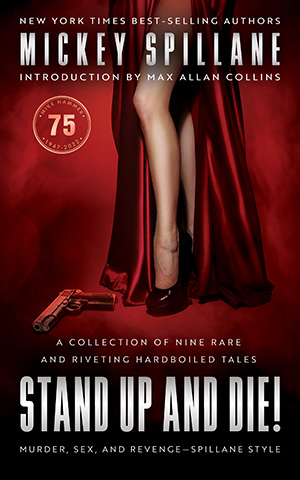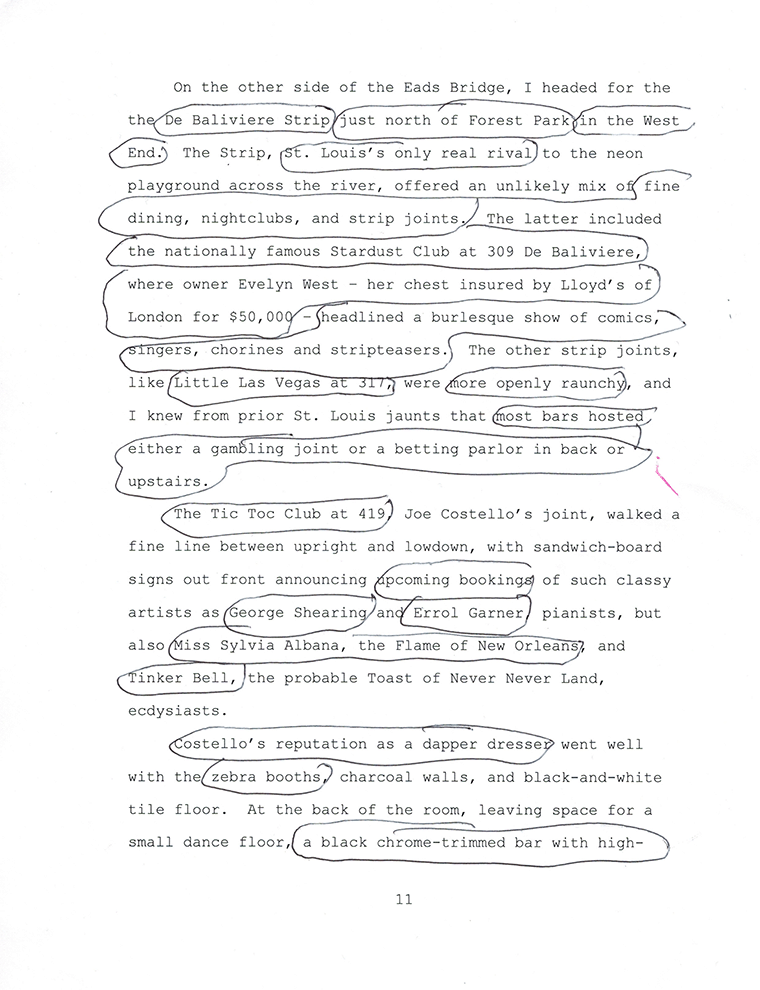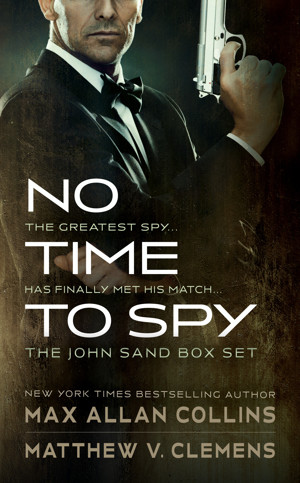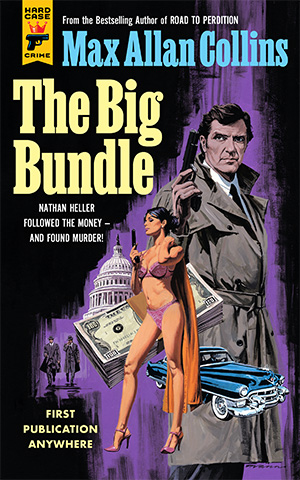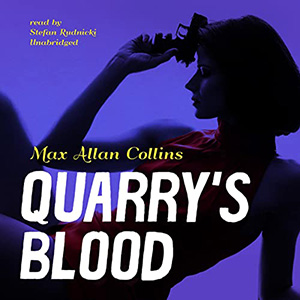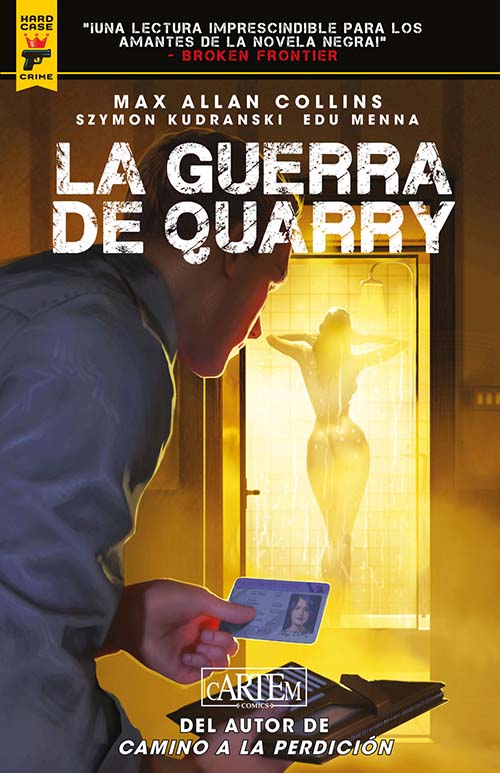STOP THE PRESSES: Supreme Justice and Midnight Haul are on sale for $1.99 each as Mystery, Thriller and Suspense Kindle book deals till the end of May. Amazon links: Supreme Justice | Midnight Haul
Stand Up and Die!, the new Mickey Spillane collection from Wolfpack’s Rough Edges imprint, goes on sale next week (May 17) as both a Kindle e-book and a physical book. I edited it (and introduced it) and contributed a new version of my very first collaboration on a Mike Hammer story with Mickey, “Tonight I Die” (originally titled “The Night I Died” and published in the Spillane/Collins-edited anthology, The Private Eyes, 1998).
These novellas and short stories are culled from two long-out-of-print anthologies I edited, Tomorrow I Die (1986, Mysterious Press) and Together We Kill (2001, Five Star). This represents all of the crime stories from both volumes collected here in one place.
Here are the contents:
“Everybody’s Watching Me” (1953)
“Together We Kill” (1953)
“The Girl Behind the Hedge” (1953)
“The Pickpocket” (1954)
“I’ll Die Tomorrow” (1960)
“Tomorrow I Die” (1956)
“Hot Cat” (1964)
“The Gold Fever Tapes” (1973)
“Tonight I Die” (2022)
The final story is a Mike Hammer tale, and the reason why I’ve done a new version – not radically different, but enough so to rename it – is a story unto itself.
The basic story of “Tonight I Die” appeared in three versions in Mickey’s files – a radio play, a thirty-minute TV show, and a sixty-minute or more TV movie. There are significant differences between versions, and I did not become aware of all three until much later.
In 1998, when we edited the anthology Private Eyes for NAL, I felt it was key that we include a Hammer short story. But there weren’t any and getting Mickey to write a new one would have tough to impossible. He had already begun to share his unpublished materials with me, just for my interest (and perhaps he was already thinking of what I might do with his unfinished work some day), and I had run across the radio play version. It seems to have been written for the radio series That Hammer Guy, possibly as a pilot. It was not to my knowledge produced, though the series ran three years.
The script was heavy with narration and I asked Mickey if I could turn it into a short story, sticking to his script. He gave his blessing. The script was heavy with narration and the transfer was not difficult, though I felt some of it could have used some work, chiefly for clarity. But I did as little as I could in that regard, basically turning the script’s present tense script into past.
Now that I’ve done so many posthumous collaborations with Mickey – with his blessing – I felt this story should be properly prepared for publication…again, without taking too many liberties.
The things I did not include from the Tomorrow I Die and Together We Kill anthologies in this new one are interesting but not vital – like the science-fiction tale “The Veiled Woman,” ghosted by Howard Browne when Mickey missed deadline; a few memoirs for True magazine; a comic book “filler” story (now available in Vintage Spillane); and the script of a Mike Hammer screen test film starring Spillane’s policeman pal Jack Stang (a short story version appearing in the forthcoming Kill Me If You Can, this year’s Hammer 75th anniversary novel, which includes five bonus short stories). Also intentionally M.I.A. is Mickey’s good but non-crime tale, “Affair with the Dragon Lady.”
Stand Up and Die! is the definitive collection of Spillane crime/mystery short fiction, and its existence is due to not just my efforts but also Wolfpack’s Mike Bray, Paul Bishop and James Reasoner.
Mickey allowed a number of his crime novellas to be collected by NAL as paperbacks, mostly two-to-a-volume. This was part of his effort to raise last-minute funds for the troubled production of The Girl Hunters film. Possibly because that need for money was over, he did not bother to collect his other novellas and short stories similarly. Over the years I collected these in their original men’s adventure magazine appearances, sometimes off the newsstands, other times in used book stores. Convincing Mickey to let me collect some of them for the Mysterious Press anthology led to our first professional project together.
Not our last.
I can’t recommend a collection of tough fiction more highly than this one.
Here’s a good review of Quarry’s Blood by a reader who can’t seem to make up his mind whether he wants me to write more Quarry books or not.
This review of the film The Outfit, streaming now, says it’s a combination of Collins (me), Mamet (a writer whose work I don’t care for), and Sorkin (a writer whose work I do care for). So I went into watching it with one eye squinted. It’s an okay crime chamber piece, with a strong central performance by Mark Rylance. You may like it. I made it all the way through, Barb didn’t. Interestingly, Barb loves the film of Tinker, Tailor, Soldier, Spy (as do I), and the reviewer here in passing calls Tinker, Tailor “dreadfully boring.” Still, having my work referenced in a review like this was fun.
Some short, smart reviews here of three Quarry books and one Nolan. I’m blushing.
Road to Perdition is listed as one of the seven best movies debuting on Netflix in May 2022.
Here’s an interesting in-depth look at Wild Dog.
Finally, this brief, admiring look at the graphic novel and film of Road to Perdition.
M.A.C.
